Analysis of Spring Core Components
Spring Core Components
Spring has many core components, but its skeleton is Core, Context and Bean.
Bean
Among the three, Bean is the core of the core. Beans implement objects through configuration files, and Spring manages object storage space and life cycle allocation. Through dependency injection, objects can be injected into specified business logic classes. These injection relationships are managed by the Ioc container.
Therefore, the core idea of Spring is often called BOP (Bean Oriented Programming), Bean-oriented programming.
Bean component is defined under Spring's org.springframework.beans package, which solves the following problems:
Definition of Bean
Creation of Bean
Parsing of Bean
Users only need to pay attention to the creation of Bean, other Both processes are completed internally by Spring.
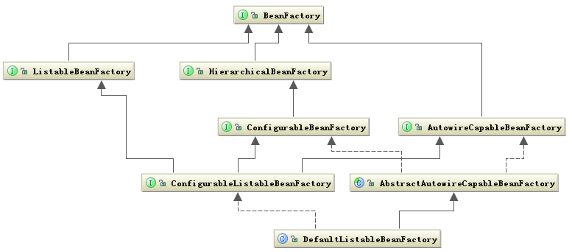
1. Overall architecture
The overall architecture of Spring Bean is a typical factory model, and the top-level interface is BeanFactory. ListableBeanFactory, HierarchicalBeanFactory and AutowireCapableBean are its subclasses in order to distinguish the data limitations of Spring's internal object processing and conversion.
ListableBeanFactory: Indicates that these beans are listable
HierarchicalBeanFactory: Indicates that these beans have an inheritance relationship
AutowireCapableBeanFactory: Defines the automatic assembly rules of beans
These interfaces respectively define Bean collections, Bean relationships and Bean relationships. Behavior.
2.Bean definition
Bean definition is mainly described by BeanDefinition, and the hierarchical relationship is as follows:
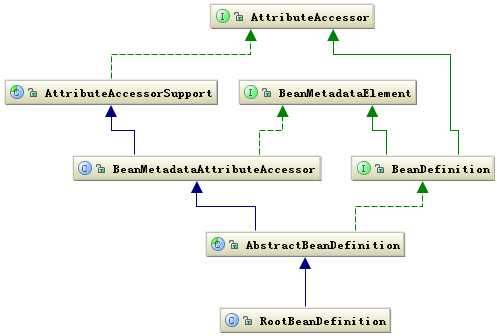
The nodes defined in Spring’s configuration file will be converted into BeanDefinition objects after successful parsing, and all subsequent operations will be performed on Performed on BeanDefinition object.
3.Bean parsing
The main task of Bean parsing is to parse the Spring configuration file and finally generate the BeanDefinition object.
The parsing process is very complex, including all tags in the configuration file. The main participating classes are as follows:

Context
Bean wraps Objects, and Objects store the data required by the business. Therefore, how to provide a survival and operating environment for these data and the relationships between them (that is, saving the state of the object) is the problem that Context needs to solve. Context is actually a collection of Bean relationships, also called an Ioc container.
ApplicationContext is the top-level interface of Context. The hierarchical relationship is as follows:
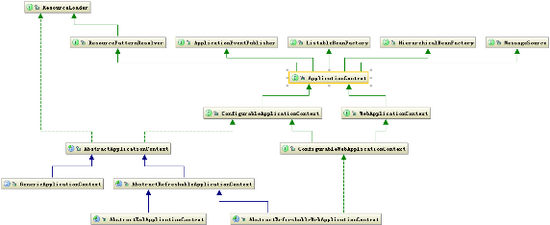
ApplicationContext can identify the basic information of an application environment. It inherits 5 interfaces to expand the functions of Context. Among them, BeanFactory is used to create beans, and it inherits ResourceLoader interface for accessing any external resources.
Subclasses of ApplicationContext, mainly include:
ConfigurableApplicationContext: A Context in which users can dynamically configure and modify information, among which AbstractRefreshableApplicationContext is the most commonly used.
WebApplicationContext:
Context prepared for web applications, which can directly access ServletContext.
In short, the functions that ApplicationContext must complete are as follows:
Identify an application environment
Use BeanFactory to create Bean objects
Save object relationship tables
Capture various events
As an Ioc container, Context is responsible for most other functions of Spring Base.
Core
Spring is a package of tools for discovering, establishing and maintaining relationships between beans, called Core. This is actually the required Util.
One of the important components of Core is Resource.
1. Overall level of Resource
Resource mainly defines the access method of resources. All resources are abstracted into the Resource interface. The hierarchical relationship is as follows:
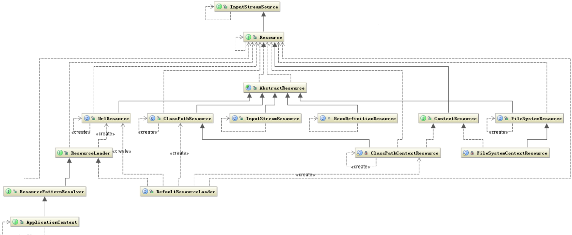
Resource packaging. Resource inherits the InputStreamSource interface upwards, and all resources are obtained through InputStream, thereby shielding the resource provider.
Resource loading. ResourceLoader interface under Resource, all resource loaders can load all resources by uniformly implementing this interface, such as the previous ApplicationContext.
2. Establish a relationship with Context
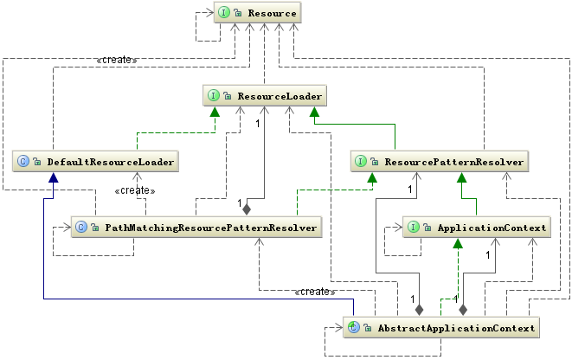
As shown in the figure, ApplicationContext interacts with ResourceLoader through the ResourcePatternResolver interface to load, parse and describe resources. ResourcePatternResolver encapsulates and integrates resources to facilitate use by other components.
Summary
This article mainly summarizes the three core components that constitute the Spring skeleton framework and the connections between them, as well as some insights into the understanding of the implementation principles of the three.

Hot AI Tools

Undresser.AI Undress
AI-powered app for creating realistic nude photos

AI Clothes Remover
Online AI tool for removing clothes from photos.

Undress AI Tool
Undress images for free

Clothoff.io
AI clothes remover

Video Face Swap
Swap faces in any video effortlessly with our completely free AI face swap tool!

Hot Article

Hot Tools

Notepad++7.3.1
Easy-to-use and free code editor

SublimeText3 Chinese version
Chinese version, very easy to use

Zend Studio 13.0.1
Powerful PHP integrated development environment

Dreamweaver CS6
Visual web development tools

SublimeText3 Mac version
God-level code editing software (SublimeText3)

Hot Topics
 Smith Number in Java
Aug 30, 2024 pm 04:28 PM
Smith Number in Java
Aug 30, 2024 pm 04:28 PM
Guide to Smith Number in Java. Here we discuss the Definition, How to check smith number in Java? example with code implementation.
 Java Spring Interview Questions
Aug 30, 2024 pm 04:29 PM
Java Spring Interview Questions
Aug 30, 2024 pm 04:29 PM
In this article, we have kept the most asked Java Spring Interview Questions with their detailed answers. So that you can crack the interview.
 Break or return from Java 8 stream forEach?
Feb 07, 2025 pm 12:09 PM
Break or return from Java 8 stream forEach?
Feb 07, 2025 pm 12:09 PM
Java 8 introduces the Stream API, providing a powerful and expressive way to process data collections. However, a common question when using Stream is: How to break or return from a forEach operation? Traditional loops allow for early interruption or return, but Stream's forEach method does not directly support this method. This article will explain the reasons and explore alternative methods for implementing premature termination in Stream processing systems. Further reading: Java Stream API improvements Understand Stream forEach The forEach method is a terminal operation that performs one operation on each element in the Stream. Its design intention is
 TimeStamp to Date in Java
Aug 30, 2024 pm 04:28 PM
TimeStamp to Date in Java
Aug 30, 2024 pm 04:28 PM
Guide to TimeStamp to Date in Java. Here we also discuss the introduction and how to convert timestamp to date in java along with examples.
 Java Program to Find the Volume of Capsule
Feb 07, 2025 am 11:37 AM
Java Program to Find the Volume of Capsule
Feb 07, 2025 am 11:37 AM
Capsules are three-dimensional geometric figures, composed of a cylinder and a hemisphere at both ends. The volume of the capsule can be calculated by adding the volume of the cylinder and the volume of the hemisphere at both ends. This tutorial will discuss how to calculate the volume of a given capsule in Java using different methods. Capsule volume formula The formula for capsule volume is as follows: Capsule volume = Cylindrical volume Volume Two hemisphere volume in, r: The radius of the hemisphere. h: The height of the cylinder (excluding the hemisphere). Example 1 enter Radius = 5 units Height = 10 units Output Volume = 1570.8 cubic units explain Calculate volume using formula: Volume = π × r2 × h (4
 PHP vs. Python: Understanding the Differences
Apr 11, 2025 am 12:15 AM
PHP vs. Python: Understanding the Differences
Apr 11, 2025 am 12:15 AM
PHP and Python each have their own advantages, and the choice should be based on project requirements. 1.PHP is suitable for web development, with simple syntax and high execution efficiency. 2. Python is suitable for data science and machine learning, with concise syntax and rich libraries.
 PHP: A Key Language for Web Development
Apr 13, 2025 am 12:08 AM
PHP: A Key Language for Web Development
Apr 13, 2025 am 12:08 AM
PHP is a scripting language widely used on the server side, especially suitable for web development. 1.PHP can embed HTML, process HTTP requests and responses, and supports a variety of databases. 2.PHP is used to generate dynamic web content, process form data, access databases, etc., with strong community support and open source resources. 3. PHP is an interpreted language, and the execution process includes lexical analysis, grammatical analysis, compilation and execution. 4.PHP can be combined with MySQL for advanced applications such as user registration systems. 5. When debugging PHP, you can use functions such as error_reporting() and var_dump(). 6. Optimize PHP code to use caching mechanisms, optimize database queries and use built-in functions. 7
 Create the Future: Java Programming for Absolute Beginners
Oct 13, 2024 pm 01:32 PM
Create the Future: Java Programming for Absolute Beginners
Oct 13, 2024 pm 01:32 PM
Java is a popular programming language that can be learned by both beginners and experienced developers. This tutorial starts with basic concepts and progresses through advanced topics. After installing the Java Development Kit, you can practice programming by creating a simple "Hello, World!" program. After you understand the code, use the command prompt to compile and run the program, and "Hello, World!" will be output on the console. Learning Java starts your programming journey, and as your mastery deepens, you can create more complex applications.






